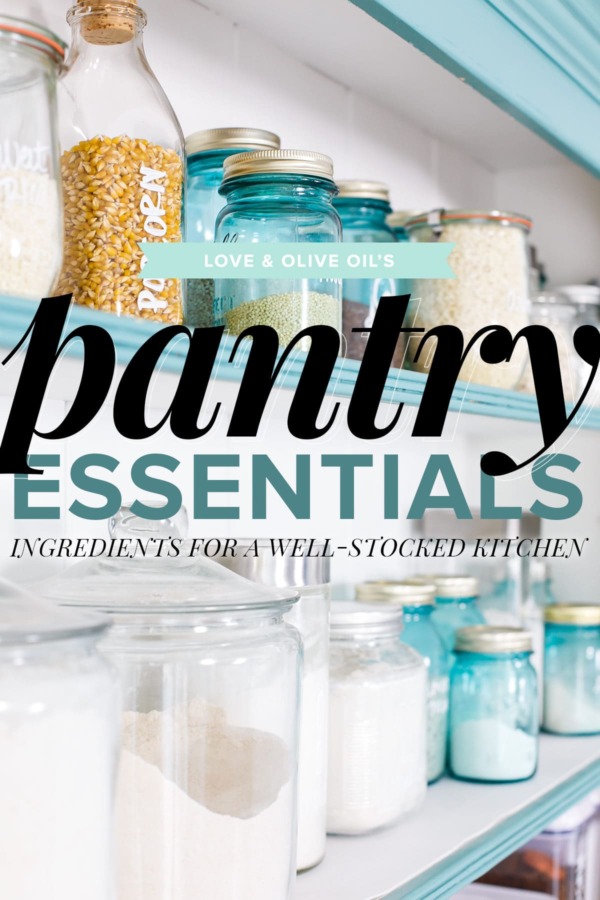
So, we’ve talked about Kitchen Essentials and we’ve talked Baking Essentials, which focused on the tools and equipment that make a kitchen both functional and practical.
Now let’s turn our focus to the pantry: with the right ingredients on hand you can easily throw together a last minute dinner when you simply can’t make it to the store, or bake up a batch of basic cookies or brownies for that surprise bake sale you didn’t know was happening (or, you know, the late night craving that hits just when the snow starts to fall…)
This post includes some of the items we use on a regular basis and like to have stocked and on hand for convenience when cooking. If you’re just starting to build your pantry, you certainly don’t have to go buy all this at once, rather slowly build up your inventory as needed. I’ve only included shelf-stable items here; pantry items that require refrigeration for storage/after opening are not included here.
Disclaimer: while this post is not sponsored and no brands have paid to be included here, many of these products were received as part of past/present brand partnerships. That said, should our kitchen be reduced to rubble today, we wouldn’t hesitate to buy them again ourselves tomorrow. Meaning, everything on this list is something we own and love and use on a regular, if not daily, basis. There are also affiliate links in this post, FYI. And if you’re reading this post in RSS or email you might want to click through to the post page for easy clickable links to every item on this list!
Oils & Vinegars
Olive Oil – Well, duh. This blog wouldn’t be called Love & Olive Oil if we didn’t use a ton of olive oil. We generally keep 3 types of olive oil on hand: an everyday olive oil (we love Trader Joe’s Turkish Olive Oil and California Olive Ranch everyday olive oil), a finishing olive oil (for dipping and drizzling), and a light or pure olive oil for frying and baking.
Vegetable Oil – For frying and sautéing, a good neutral oil with a high smoke point is important to have on hand. I personally like sunflower oil, but canola oil, peanut oil, or even grapeseed and/or avocado are other great options (avocado oil actually has one of the highest smoke points of all of them!) Grapeseed and avocado oil double as good oils for salad dressings and even baking too.
Sesame Oil – For Asian recipes, a few drops of toasted sesame oil works wonders. I recommend storing sesame oil in the fridge to keep it from going rancid (I know I said I’d only include shelf-stable items here but this is the exception).
Balsamic Vinegar – From a super simple salad dressings to a stand-alone accompaniment for good bread, balsamic vinegar is easily one of the most used condiments in our kitchen. I’ve even used it to make preserves and desserts! We use a nice middle of the road balsamic, one that’s not super watery like the cheap ones but still reasonably priced.
Cider Vinegar – The best for homemade pickles, cider vinegar has more flavor and character than white vinegar (though sometimes I use a mix if I want a clearer brine). Also a favorite natural remedy (if you can stomach it). Look for a good unfiltered cider vinegar like Bragg’s for the best flavor and health benefits.
Red Wine Vinegar – A great all-purpose vinegar for salad dressings, sauces and marinades. While they make white wine vinegar and champagne vinegar and sherry vinegar, red wine is definitely the most versatile in my opinion than the others.
Rice Vinegar – If you do a lot of Asian cooking, rice vinegar is a must. It has a lighter and sweeter flavor than other vinegars. Note there is a difference between seasoned rice vinegar and rice vinegar, but rice wine vinegar is the same thing is rice vinegar. Seasoned rice vinegar has added salt/sugar and while more flavorful, we typically stick with a basic unseasoned rice vinegar unless a recipe specifies otherwise.
Baking
Flour – At the very least, you should have All-Purpose Unbleached flour in your kitchen at all times. If you have the space, a good bread or high protein flour is nice to have for homemade bread, pizza doughs, and pastas. Cake flour is much finer and lower protein and produces a vastly superior crumb than regular AP. Whole Wheat White flour is a great swap when you want to be a little bit healthier (I usually do a 50:50 mix to avoid things getting too dense). Of course, if you get really into it it’s easy to end up with dozens of flours, from specialty grains like rye and spelt to extra finely milled flours for pizza and pasta. Essential? Probably not. But gosh darn fun to play around with.
Sugar – Plain white granulated sugar and light brown sugar are essential if you do any amount of baking. Too many times I’ve run out of sugar and it has completely thwarted my weekend baking plans. I’ve learned to stock up. While white sugar is easy to buy in bulk, brown sugar will turn rock hard if not stored in an airtight container. If you have the space, a nice muscovado or dark brown sugar is a flavorful addition. Powdered or confectioner’s sugar is also useful to have for frostings and icings.
Yeast – I like Red Star Active Dry yeast, which I buy in larger bags and transfer to a mason jar that I store in the freezer. But the little packets of Active Dry or Instant yeast are always convenient to have on hand (just check that they aren’t expired before you use them).
Vanilla – A good bottle of vanilla extract will add flavor and depth to your desserts. Whether you buy a bottle or make your own, pure vanilla extract/essence is a baker’s best friend (just avoid the imitation stuff, please!) If you have the space, vanilla bean paste is a lovely ingredient (I pretty much use this anywhere it calls for a whole vanilla bean.
Chocolate Chips – Trust me, the one time you run out of chocolate chips you’ll be hit by the biggest craving for chocolate chip cookies ever. I usually have a few different kinds on hand including semisweet, dark, mini chips and chocolate chunks, but as long as you have a bag of basic semisweet chocolate chips you’re safe in case of emergency.
Baking Chocolate – Chocolate chips are not made for melting. While they will work in a pinch, in situations where melted or tempered chocolate is required (brownies, truffles, etc), I recommend having baking chocolate on hand, either in bar form, or in easy to manage discs/callets/wafers that melt easily with no chopping required. A good quality dark chocolate (60-70%) is incredibly versatile; but if you have the space you can play with other percentages or even white chocolate as well.
Cocoa Powder – I prefer Dutch-processed cocoa; I used to have natural as well but I never used it. I buy big 2.2lb bags of Cacao Barry Extra Brute Cocoa powder. It’s my favorite flavor-wise and fairly economical for the price.
Cornstarch – Cornstarch is often used in baking, but also for thickening soups and sauces. I like the kind that comes in canisters as it’s easier to store and measure without making a massive mess. Tapioca starch or potato starch are good substitutions.
Baking Soda & Baking Powder – Pretty much can’t bake without them! These items do have a limited shelf life, so be sure to check expiration dates before you use. Know that while you CAN swap baking powder with baking soda (mixed with a bit of cream of tartar for acidity), you CANNOT substitute baking powder for baking soda (I’ve been baking for 30+ years and I still can’t keep them straight).
Sprinkles – I mean, d’oh. It’s a universal truth that rainbow sprinkles make everything better (I personally can’t get enough of the gorgeous sprinkle mixes from Sweetapolita). But chocolate jimmies are always good to have on hand too.
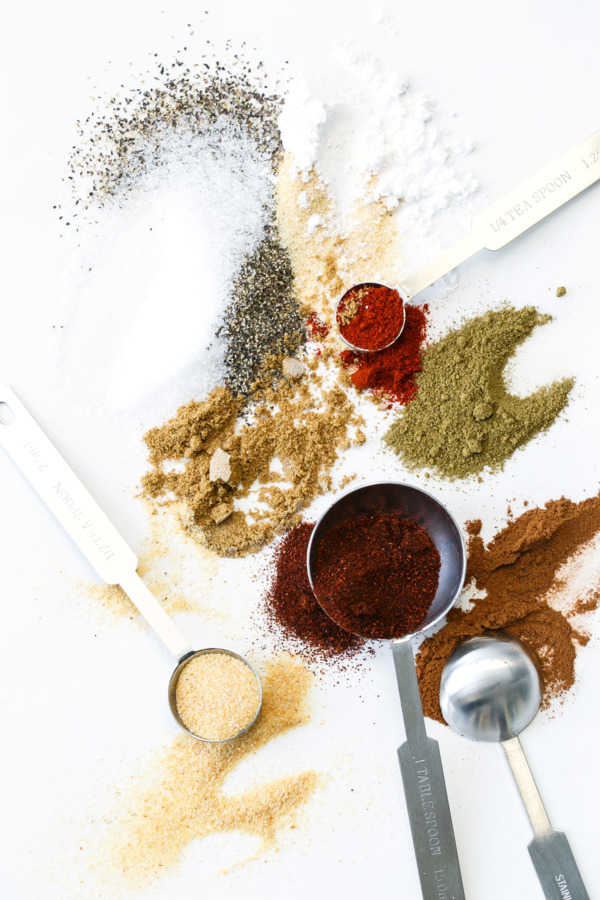
Spices & Seasonings
Salt – Salt might be the most important ingredient in all cooking and baking. At the very least, have a solid supply of kosher salt (I like Diamond Crystal brand kosher salt) on hand, which can be used for seasoning, brining and baking, and doesn’t have any anti-caking agents like other brands. Keep a salt cellar full of this next to the stove as you cook for easy pinch-by-pinch seasoning. If you have the space, a good flake salt such as Maldon is great for finishing dishes and sprinkling on desserts, and a fine sea salt is perfect for popcorn.
Pepper – Unlike salts, black pepper is pretty much the same across the board. I prefer freshly ground, so I buy big bags of whole peppercorns at my local international market so I always have some on hand to fill up my pepper grinder.
Spices – You can buy entire ‘starter’ sets of spices, but often times these pre-assembled sets don’t always include the really useful stuff (I mean, who uses marjoram?) Of course, this will vary from cook to cook, but for us, the most commonly used spices in our kitchen include cinnamon, ginger, cumin, smoked paprika, red pepper flakes, and chili powder or cayenne pepper. Second tier spices include nutmeg (whole, preferably), fennel, garlic powder, bay leaf, sesame seeds, and sweet paprika, as well as herbs like thyme, sage, dill and oregano (though in the summertime especially I often use fresh versions of these from the garden). The other 62 spices in your drawer/rack? Well, they’ll probably expire before you can use the whole jar.
Sweeteners
Honey – Did you know that honey never expires? Even if it crystalizes, just microwave it for a few seconds to bring it back to life. I try to avoid the super cheap honey since they all seem to have the same fake flavor. Once you start trying different varieties you’ll be amazed at the flavor variations! My current favorite is Trader Joe’s Turkish Honey, which has a lovely licorice undertone. Local raw honey is said to be great for those with seasonal allergies.
Maple Syrup – Another alternative sweetener that is always handy to have on hand, and not just for pancakes. You don’t need the super expensive stuff, just a solid grade B maple syrup is a great choice for baking.
Corn Syrup – It’s not as evil as you’ve been lead to believe, and light corn syrup is necessary for certain recipes like pecan pie and marshmallows, and helpful for preventing boiling sugar from crystalizing. Unless you’re making a pecan pie regularly, you probably don’t need dark at all. Lyle’s Golden Syrup is a great substitute if you’d rather avoid corn syrup entirely.
Canned Goods
Canned tomatoes – I try to only buy tomatoes when they are in season, which leaves about 9 months of the year when they aren’t. It’s then that canned tomatoes are a godsend. I usually have a few big cans of whole San Marzano tomatoes (the best for tomato and pizza sauces), as well as diced tomatoes and tomato puree (while you can always make your own puree using whole tomatoes if you need to, it’s rather handy to have it already done for you).
Tomato paste – In addition to the above, tomato paste is a great foundation for many sauces and stews, even if the final product isn’t overly tomato-y. I love the tubes of tomato paste that are available now, because they are easy to portion out a tablespoon or two. But a few cans are helpful too for sauces and recipes that require large quantities. If you have leftover tomato paste, it freezes beautifully.
Anchovies – Don’t scrunch your nose. Anchovies are the secret ingredient to super flavorful Italian cooking. Add one or two with your oil and garlic before building your pasta sauce and be amazed at how rich the flavor becomes! Anchovies typically come in cans or jars; refrigerate after opening or freeze what’s left for longer storage.
Pumpkin – Sometimes you want pumpkin when it’s NOT October; for that reason I always pick up a few extra cans each year to get me through the year.
Coconut Milk – Quality, full-fat coconut milk is a staple of many Indian and Asian dishes, and also a great dairy-free substitute for milk in baking. Low-fat coconut milk is thinner and doesn’t separate as much, which can be useful sometimes as well. If you can find a product without added gums or thickeners, even better (Chaokoh is my favorite brand).
Broth/Stock – I always try to keep a few cans or cartons of chicken, beef, and vegetable stock on hand. I prefer low-sodium versions since then I can control my own salt in recipes. In general, stocks tend to be richer and more flavorful than broths. Kitchen Basics is a great brand to look for, though I’ve found Trader Joe’s new stocks to be fabulous as well.
Rice & Grains
Beans – Black beans, garbanzo beans, and white beans are our most used varieties. A few cans are always handy to have on hand for last minute meals, but I prefer dried beans for flavor and texture (when I have the time and foresight to soak them ahead of time).
Rice – There are eleven million (give or take) different kinds of rice out there. Depending on what kind of cooking you do most, a basic white jasmine rice (Asian) or basmati rice (Indian/Mexican) is probably the most versatile.A good brown rice, maybe a sticky sushi rice (if you like to make your own sushi), and a medium-grain Arborio rice (for risotto) are also great versatile options.
Pasta – For those nights when you just want a fast dinner without a trip to the store, it’s always a good idea to keep a few bags of pasta on hand. I mean, if you have this and some canned tomatoes you’ve got the world’s easiest dinner.
Rolled Oats – Old fashioned (ie not quick) oats are the best kind for recipes such as homemade granola and oatmeal cookies.
Quinoa/Farro/Bulgar/Barley – An alternative grain is always handy to have, when you don’t feel like pasta but want something hearty and filling as a base. Pick your favorite, they’re pretty much interchangeable in most recipes.
Bread Crumbs – From meatballs to chicken tenders, breadcrumbs are functional and flavorful. I prefer panko breadcrumbs in most situations if only for the extra crunch; regular breadcrumbs always seem extra dry to me. Stick with unseasoned, you can always add seasoning if you need to.
Garlic – Being out of garlic is almost as bad as being out of sugar or chocolate chips. Garlic powder just isn’t quite the same. Store garlic in a cool, dark place in a well ventilated container, basket, or mesh bag. They’re still usable if they start to sprout (as long as the cloves aren’t moldy or mushy) but older, sprouted garlic will have a sharper flavor.
Onions – Much like garlic, onions keep very well in dry, dark environments for months, and are technically still ok to eat if they have sprouted (though the flavor might have changed). Red onions and yellow onions are the most versatile varieties, though you can’t beat sweet onions for French onion soup.
Potatoes – Another technically perishable food item that can keep quite well if properly stored in a well ventilated box or container in a cool, dark and dry place. Don’t store your potatoes near your onions as they’ll cause each other to spoil much faster. Cut off any sprouts or green spots before eating.
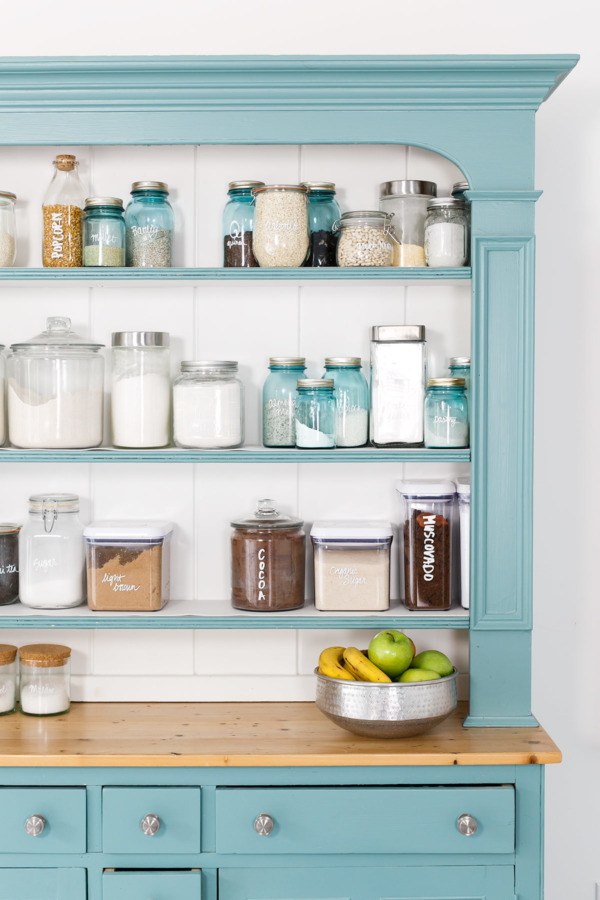
Storage
Now that you have all your essentials, you have to organize them so they’ll all fit in your pantry and be easily accessible when you need them. There are entire businesses out there based around beautifully organized pantries, but, alas, we don’t all have that luxury. Still, simply transferring many of your dry goods to classy containers makes a world of difference.
Pop Containers – For items that can benefit from airtight storage (like brown sugar, for example), OXO’s Pop Containers are one of the best products out there. They come in a variety of sizes that hold everything from spices and seeds to full bags of flour.
Glass Jars – If any part of your pantry is open, having pretty storage containers will make your space that much more appealing. I went the mis-matched route, collecting assorted glass jars and containers over the years. I have a bunch of random mason jars (some new, some vintage blue jars), some larger Weck jars, and a bunch of different canisters (most of which I got from World Market). I label my glass containers using a chalk marker.
Organizers – Sometimes just arranging things so you can more easily see everything is all it takes. I mean, if that can of black beans is buried behind a bunch of other stuff you’ll probably forget you have it, right? A nice multi-level can organizer is much more practical and attractive than stacking all your cans. Lazy Susans are also great items to have in your pantry: I have one dedicated entirely to sprinkles.
Baskets & Bins – For less-attractive items that you maybe can’t transfer to other containers, having some nice uniform baskets or bins can keep your pantry nice and orderly. I personally like clear bins so I can see what’s inside, I have a few different sizes of bins for random things like pasta, chocolate chips, and used canning jar lids.
***
With a well stocked and well organized pantry you are armed and ready to start cooking and baking from scratch, without having to constantly be running to the store to pick up a missing ingredient. It’s the first steps to becoming a better cook!
I’ve told you, now, you tell me…
What are your essential pantry ingredients?
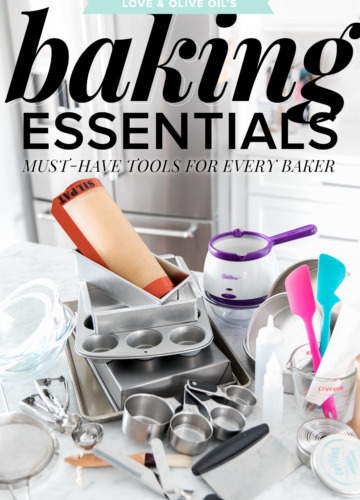
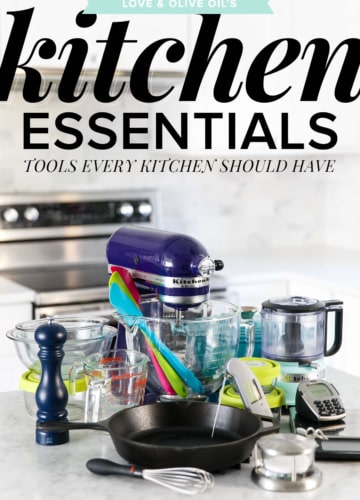
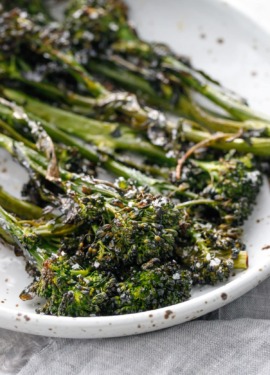
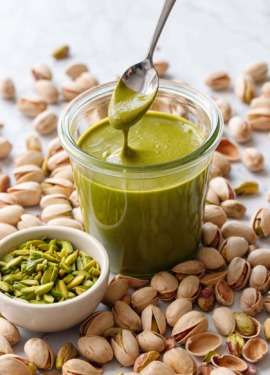
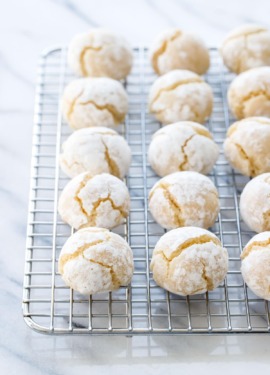
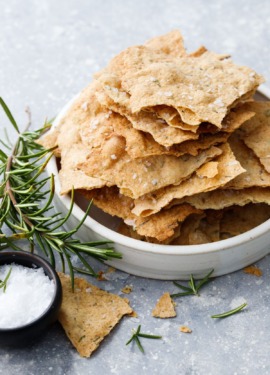
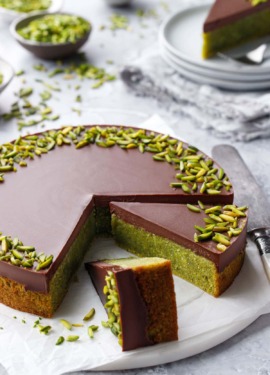
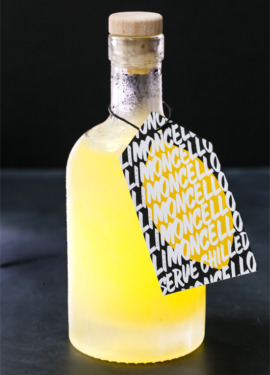
Dried cranberries are always in my pantry. Great for snacking, baking, and even a few casseroles. Many a last minute cookie or trail mix has benefited from my stash of dried cranberries.
I have every single item on this list on hand with the exception of anchovies. I can honestly say I have never purchased them in my life :)
TJ’s turkish honey, their olive oil, I used their sesame oil, and I know you said you like to refill your pepper grinder but I love the basic black pepper clear plastic grinder from TJs. The pepper comes out very coarse and chunky so if you love pepper, you will enjoy it but the biggest bonus…you can actually see the pepper show up on photos.
I can an entire 2 shelves devoted to Sweetapolita sprinkles at the expense of buying other gadgets, products, etc. since my space is veryyyyyy tight.
Kind of a weird one, but nonfat dry milk has gotten me out of a few jams when I ran out of milk. So now I always have it in my pantry.
That’s a great one! I definitely have dry milk on hand most of the time. I also love dried buttermilk, since who can remember to have buttermilk on hand at all times, lol.
Love your pantry pictures – great color! Don’t forget our Capay Valley Ranches olive oil. My customers are still loving your recipe for the Meyer Lemon olive oil cookies. New infusions coming this year. We’ll need to do another recipe.
Oh, I really love the mix and match glass containers, but especially the vintage blue mason jars! Seeing how pretty your pantry is with varied containers puts my OCD mind at ease about having everything be all matchy matchy! I’ve been collecting POP containers at HomeGoods as I see them because they are so expensive, but now totally digging this idea to mix in other glass jars.
The blue jars are leftover from our wedding, believe it or not! lol. But I believe Ball has released some vintage-inspired colors in the last year or so, blue and purple I think? I think it’s a fun mix!
Whew! Sprinkles are on the list, it’s all gonna be ok. ha! Joking aside, this is a stellar primer for pantry stocking, and I feel like I learned a thing or five.
Well duh. Who do you think I am, a monster?!